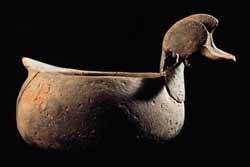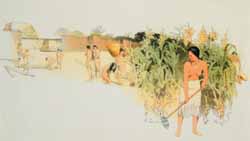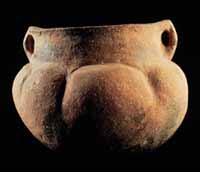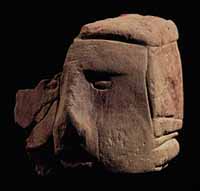
 |
Duck effigy pot, Dickson Mounds site, Fulton County. | |
|
Archaeologists study food remains-animal bones and charred seeds and nutshell, among other things-to learn about what people ate, when and where they went to find food, and how they captured, collected, and processed food. Using this information, archaeologists then try to understand why certain foods were preferred as opposed to others. Ducks were plentiful during the fall of the year and could be caught in large numbers with nets. |
||
The Mississippian diet consisted of a mix of wild and cultivated food. Mississippian people continued to eat the same wild foods used by their Archaic and Woodland ancestors. White-tailed deer (Odocoileus virginianus) remained an important source of food, but their numbers may have been quickly reduced near large communities. Mississippian hunters also pursued a variety of small animals such as rabbit (Sylvilagus), muskrat (Ondatra zibethicus), beaver (Castor canadensis), raccoon (Procyon lotor), and turkey (Meleagris gallopavo). Archaeozoologists also find the bones of waterfowl, amphibians, reptiles such as turtle, and substantial quantities of fish in Mississippian food refuse. Fish, in particular, was an important source of protein in the Mississippian diet.
Wild plants also continued to be an important part of the diet. In the summer and fall fruits like plums (Prunus nigra), grapes (Vitis), blackberries (Rubus alumnus), and raspberries (Rubus occidentalis) were collected. In the fall, nuts such as walnut (Juglans nigra), pecan (Carya illinoensis), butternut (Juglans cinerea), hickory (Carya), and acorns (Quercus) were gathered.
 |
Artist's illustration of a woman cultivating corn. | |
|
Corn is originally a tropical plant and was domesticated in what is now Mexico by Native Americans. Two-thousand-year-old charred corn kernals have been found at a Woodland site near East St. Louis, but it appears that corn was not an important part of the diet until thirteen hundred years ago or A.D. 700. Mississippians depended on corn for food, and they cleared and planted fields near their towns and villages. |
||
The amount of cultivated plant food in the Mississippian diet distinguishes it from the typical Woodland period diet.
Native plants like goosefoot (Chenopodium bushianum) and sunflower (Helianthus annuus) continued to be cultivated, but more productive plants, not native to Illinois, became most important. Non-native crops-corn (Zea mays), squash (Cucurbita), and eventually beans (Phaseolus vulgaris)-soon became mainstays of the Mississippian diet.
 |
Pottery jar, Dickson Mounds site, Fulton County. | |
|
Pottery containers were used for storing, preparing, serving, and eating food. The handles on this pot may have been used to suspend it over a fire to slowly cook a stew mixture of corn and meat. |
||
The agricultural revolution was about more than cultivating plants. It meant new foods. Different foods could be mixed together in pots and simmered over a fire. Soups, stews, and boiled foods were ancient recipes, but they were given new flavor with the addition of corn and beans
The productivity of these cultivated plants resulted in larger quantities of food, some of which could be stored for use during the winter when food was scarce. Some of the grain was also stored as seed stock for planting next spring. A more stable food supply also allowed larger numbers of people to continue to live together in villages during the lean months of the year. Prior to the availability of cultivated plants, some family groups left their warm-weather villages for winter camps where they had a better chance of surviving when food was relatively scarce.
As noted before, the consolidation of large numbers of people in villages and the increased dependence on cultivated plants had health consequences. The skeletal remains of Mississippian people often show evidence of chronic illnesses. There is also evidence for an increase in infant mortality. Both of these health problems may have been caused by having more carbohydrates and less protein in their diet. Nevertheless, agriculture created and sustained Mississippian life, and it changed forever the lives of these early residents and all of us who now live in Illinois.
 |
Human head block pipe, Orendorf site, Fulton County. | |
|
Mississippian gardens also included non-food plants such as tobacco. First cultivated during the Woodland Period, tobacco was probably used for rituals rather than recreation. This smoking pipe is carved into the form of a human head from sandstone. The pipe bowl was drilled into the stone behind the face. A hole for the pipe stem was drilled into the back of the pipe. |
||
|
|
Copyright © 2000 Illinois State Museum